
.png)
In today's digital workplace, email is one of the most frequently used forms of communication. Whether you're applying for a job, corresponding with a client, or communicating with colleagues, the way you express yourself in an email speaks volumes about your professionalism, clarity, and credibility.
Unlike face-to-face communication, emails lack tone, body language, and immediate clarification. This means that even well-intentioned words can come across as rude, confusing, or careless if you're not paying attention. That’s why mastering email etiquette isn't just a good idea—it’s a business essential.
Emails are permanent records. Once you hit send, your message can be forwarded, archived, or even used as reference in future decisions. And in a professional setting, impressions count. Poorly worded emails can damage relationships, slow down workflows, or even cost you opportunities.
The words and phrases you choose reflect not just what you're saying, but how seriously you take your communication. Missteps like using overly casual language, including negative phrasing, or making grammar errors can create unnecessary friction, misunderstanding, or worse—make you seem unprofessional.
Another critical reason to improve your email habits is that emails are often the first or only form of communication someone has with you. That first impression, whether it’s with a potential employer, a vendor, or a new lead, can determine whether they take you seriously—or move on to someone else.
Just as you wouldn’t walk into a boardroom in sweatpants or speak to a manager using slang, the same standards apply in written correspondence. Professional email writing is about striking the right tone—confident, respectful, and clear—without sounding robotic or cold.
In this blog, we’ll highlight 15 things you should never say in a professional email, from careless phrases to words that carry unintended negative weight. You’ll also learn what to say instead and why it makes a difference.
Whether you're a freelancer, corporate professional, or business owner, improving your email communication will elevate your professional brand, foster better relationships, and help you avoid embarrassing mistakes that are surprisingly common in today’s workplace.
Let’s sharpen your email game with smart, strategic writing.
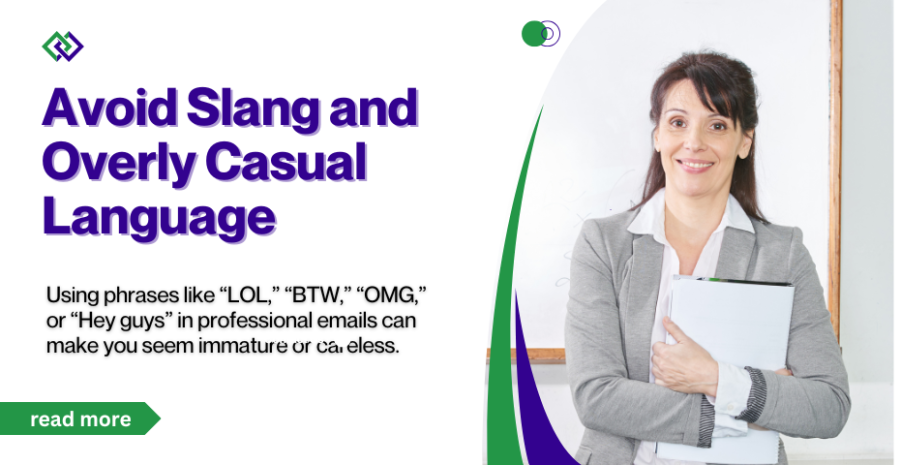
Using phrases like “LOL,” “BTW,” “OMG,” or “Hey guys” in professional emails can make you seem immature or careless.
Even if you're writing to someone you’re friendly with, remember that emails can be shared, forwarded, or reviewed by others. Slang undermines your message's credibility and may confuse recipients from different cultures or generations.
Keep your tone friendly but professional. Say “Hello team” instead of “Hey guys,” or “Just a quick note” instead of “FYI.” Casual phrases may work in chats, but in email, professionalism should always take priority.
Use clear, formal language that leaves no room for misinterpretation.
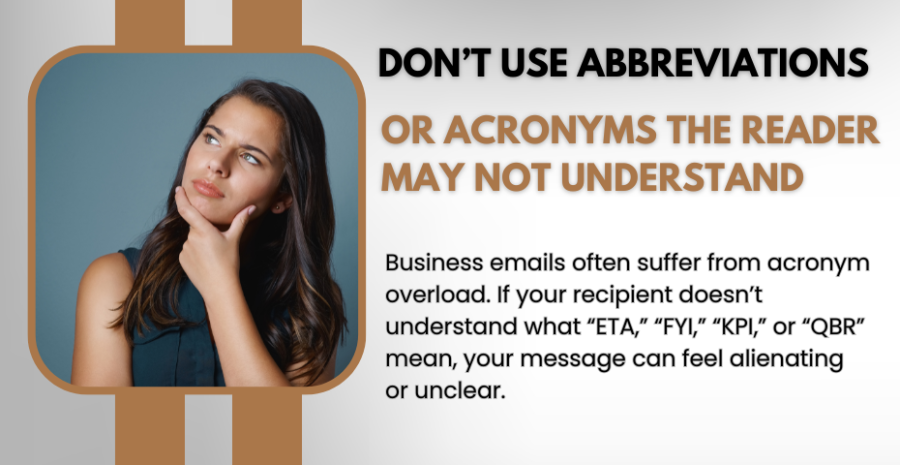
Business emails often suffer from acronym overload. If your recipient doesn’t understand what “ETA,” “FYI,” “KPI,” or “QBR” mean, your message can feel alienating or unclear.
Even worse, they may misinterpret your meaning. Always consider who your audience is and whether they’re familiar with your terminology.
The rule of thumb: if the abbreviation isn’t universal, spell it out—at least the first time.
For example, write “Estimated Time of Arrival (ETA)” before using “ETA” later.
Clear communication means making your message accessible, not coded.
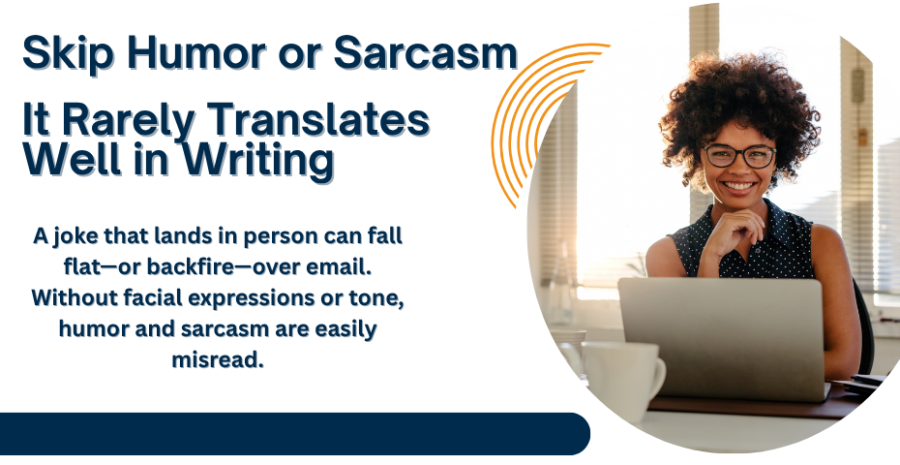
A joke that lands in person can fall flat—or backfire—over email. Without facial expressions or tone, humor and sarcasm are easily misread. “Nice job, genius” may be meant playfully but could sound insulting in writing.
Even emojis, while widely used, can seem unprofessional depending on the context and industry.
If you’re unsure how your humor will land, leave it out. Instead, focus on friendly and respectful wording.
Let professionalism be the tone, and save the jokes for face-to-face interactions where your intention is clear.
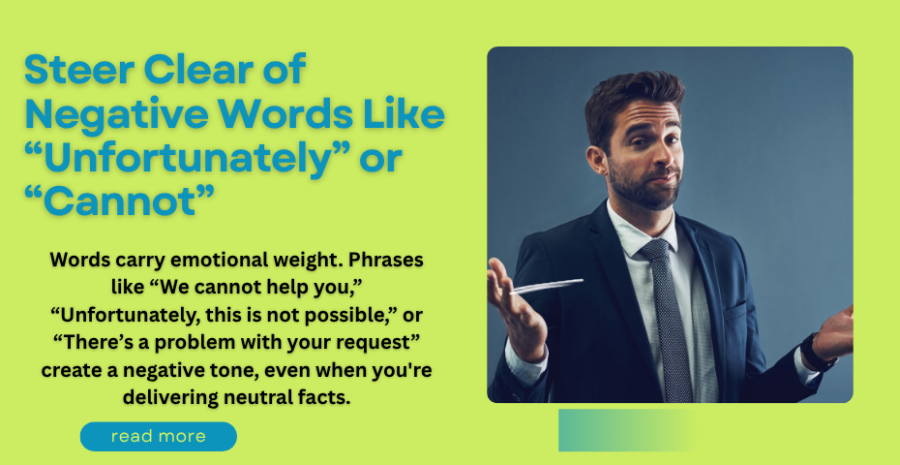
Words carry emotional weight. Phrases like “We cannot help you,” “Unfortunately, this is not possible,” or “There’s a problem with your request” create a negative tone, even when you're delivering neutral facts.
These words shut doors rather than open them. Instead, use positive or solution-oriented language. Say, “Here’s what we can do,” or “While we can’t do X, we’d be happy to help with Y.” Reframing negatives into possibilities improves the tone and keeps the conversation constructive.
Choose words that build bridges, not walls.

Admitting ignorance isn’t the problem—refusing to offer help is. When you say “I don’t know,” it can sound like you’re unwilling to assist or disinterested in finding a solution.
A better approach is to show initiative. Try, “I’m not sure offhand, but I’ll check and get back to you,” or “Let me confirm that and follow up shortly.”
This small shift demonstrates responsibility, responsiveness, and a commitment to delivering answers. It turns a dead-end into a roadmap.
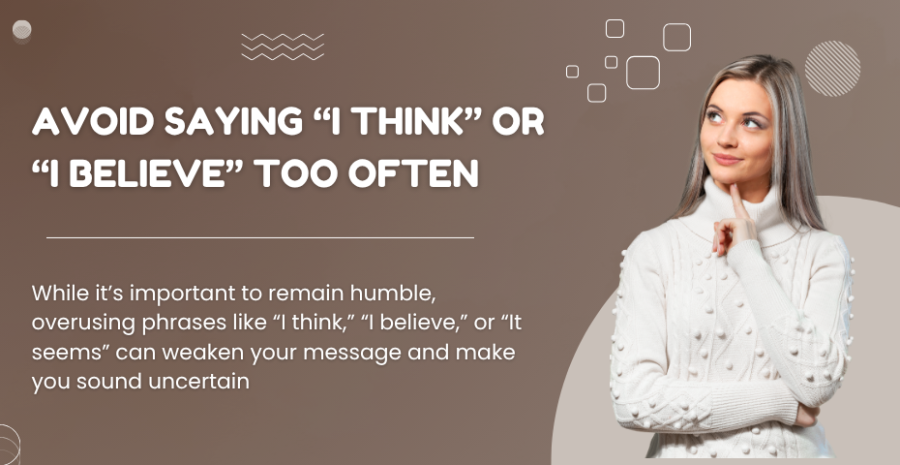
While it’s important to remain humble, overusing phrases like “I think,” “I believe,” or “It seems” can weaken your message and make you sound uncertain.
If you're offering a decision, recommendation, or update, state it confidently.
Instead of “I think we should proceed with the new vendor,” say, “I recommend we proceed with the new vendor.”
Confidence inspires confidence. Of course, if you are genuinely speculating, it’s fine to qualify—but don’t hide behind hedging language when clarity is called for.
.png)
How many times have you sent an email saying, “Attached is the file,” only to realize you forgot the actual attachment?
This common mistake can appear careless and unprofessional. Always double-check before sending, and consider writing your message first, then attaching files before entering the recipient’s email.
Some platforms even remind you when the word “attached” is used without a file. Better yet, mention the document clearly: “Please see the attached proposal for your review.”
Avoid apologizing with “Oops!”—instead, say, “Apologies, here is the file I intended to send.”
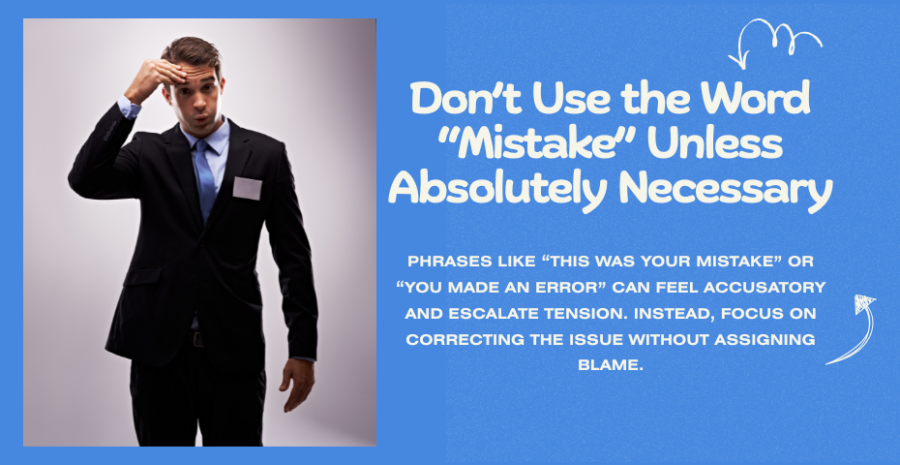
No one likes being told they made a mistake—especially in writing.
Phrases like “This was your mistake” or “You made an error” can feel accusatory and escalate tension. Instead, focus on correcting the issue without assigning blame.
Try, “It looks like there was a discrepancy—let’s review this together,” or “I noticed something we may want to adjust.”
This approach fosters collaboration and keeps the tone respectful. If you must address an error, do so with tact and empathy.
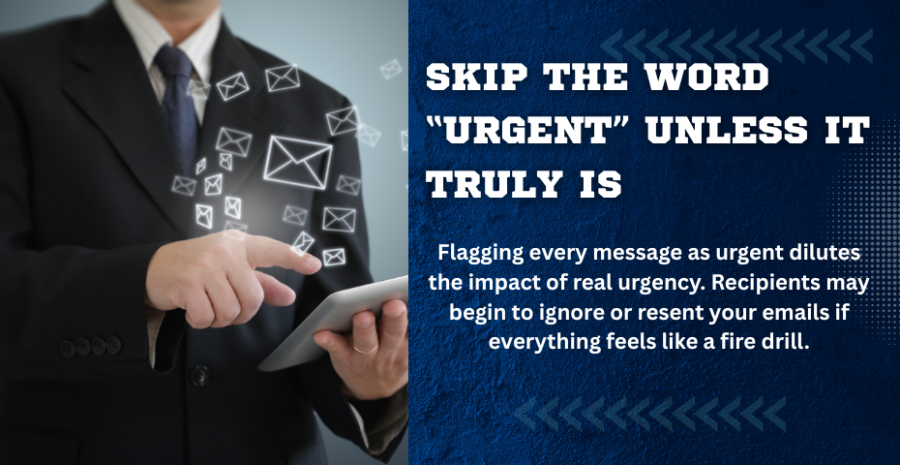
Flagging every message as urgent dilutes the impact of real urgency. Recipients may begin to ignore or resent your emails if everything feels like a fire drill.
Only mark messages as high priority when time sensitivity is critical—and make sure you explain why. Instead of using “URGENT” in all caps, say, “This requires your feedback by Friday to meet our deadline.” Set clear expectations and deadlines without sounding alarmist.
Overusing urgency reduces your credibility and creates unnecessary pressure.
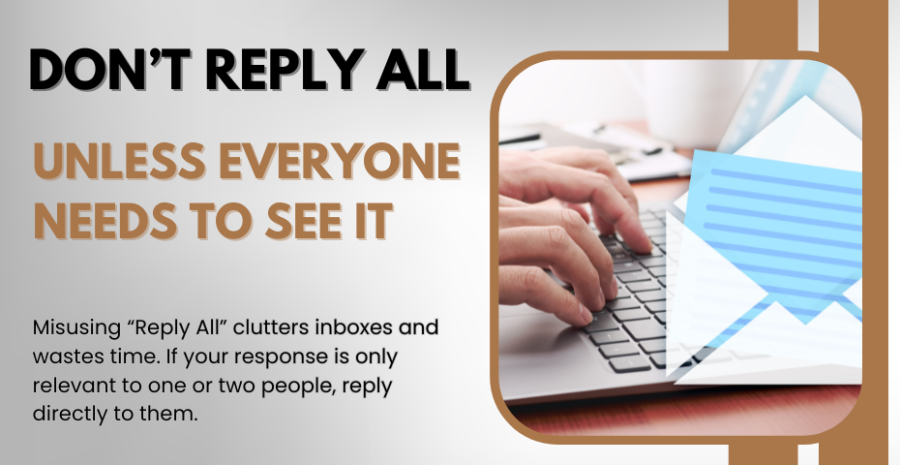
Misusing “Reply All” clutters inboxes and wastes time. If your response is only relevant to one or two people, reply directly to them.
Before clicking “Reply All,” ask yourself: “Does everyone on this thread need to know this?” Over-communication creates noise.
When in doubt, keep it focused and respect your coworkers’ time.
Clear, direct replies show that you’re intentional and efficient in how you communicate.
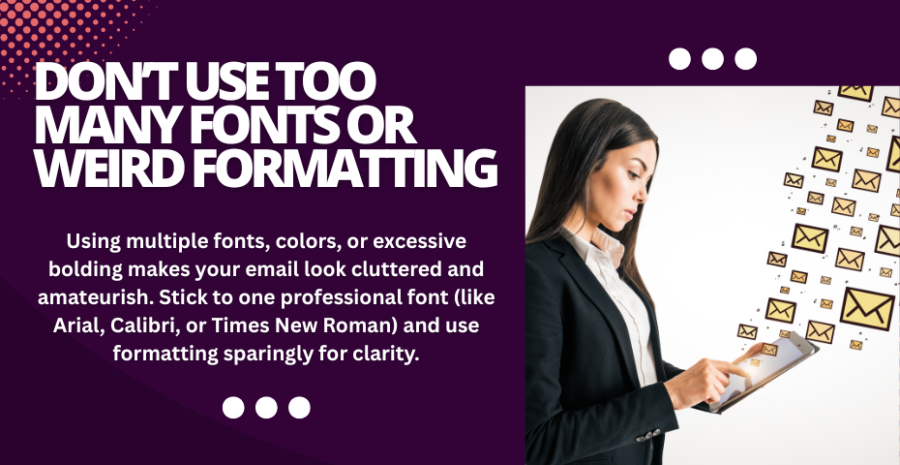
Using multiple fonts, colors, or excessive bolding makes your email look cluttered and amateurish. Stick to one professional font (like Arial, Calibri, or Times New Roman) and use formatting sparingly for clarity.
Keep paragraphs short, and use bullet points or headers for organization if needed. Clean formatting enhances readability and shows that you respect the reader’s time.
Avoid using colors like red, which can come across as aggressive or alarming.
Let your words—not your font choices—do the talking.
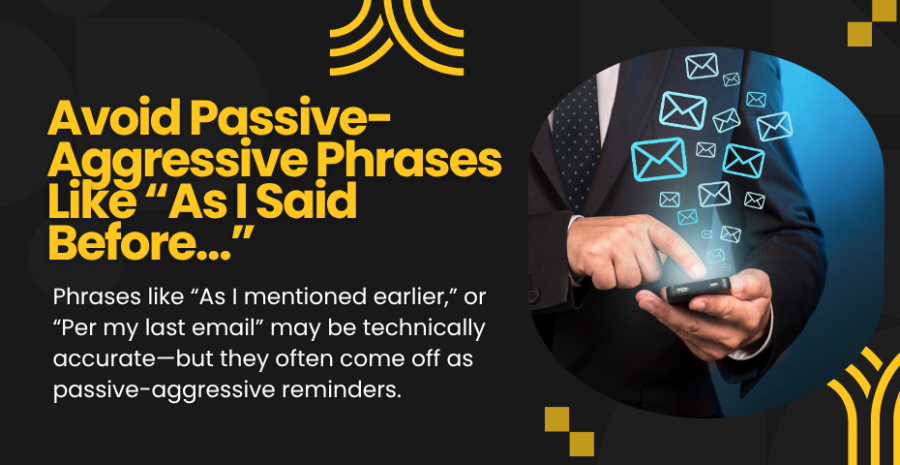
Phrases like “As I mentioned earlier,” or “Per my last email” may be technically accurate—but they often come off as passive-aggressive reminders.
Instead, try softening the tone: “Just bringing this back to the top of your inbox,” or “Following up to ensure this didn’t get missed.” Professional communication should focus on resolving, not reprimanding.
Keep reminders polite and avoid anything that feels like you’re scolding the recipient.
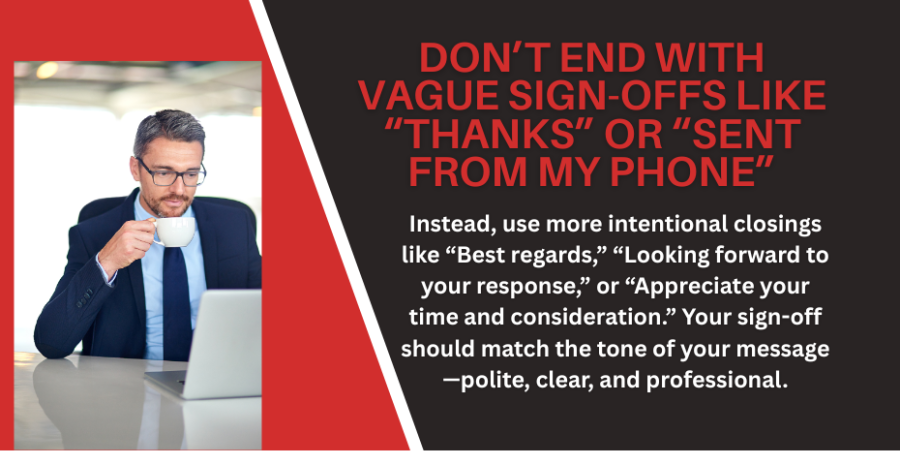
Sign-offs are your final impression. A lazy “Thanks” or “Sent from my iPhone” lacks thought and polish.
Instead, use more intentional closings like “Best regards,” “Looking forward to your response,” or “Appreciate your time and consideration.” Your sign-off should match the tone of your message—polite, clear, and professional.
It’s a small detail that makes a big difference in how your message is received.
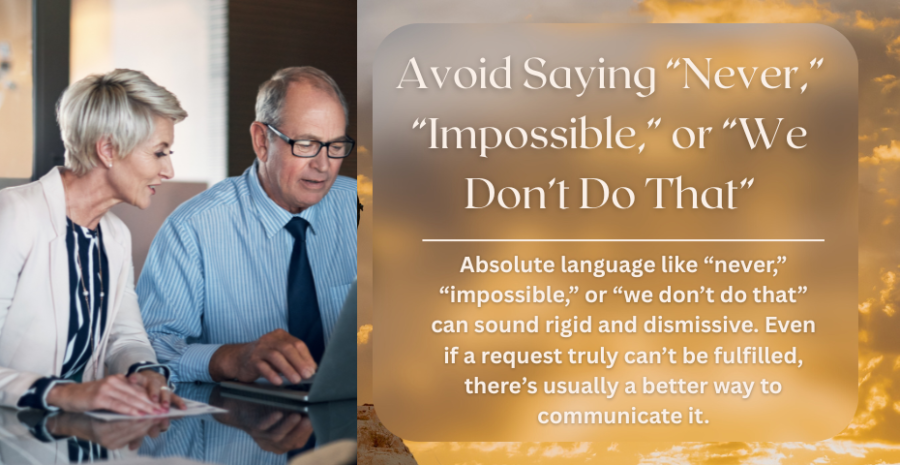
Absolute language like “never,” “impossible,” or “we don’t do that” can sound rigid and dismissive. Even if a request truly can’t be fulfilled, there’s usually a better way to communicate it.
Try saying, “That’s not something we currently offer, but here’s what we can do,” or “We’re unable to accommodate that request, but we’d be happy to explore alternatives.”
The goal is to maintain a cooperative tone, even in difficult conversations.
Your professionalism is often remembered more than the answer itself.
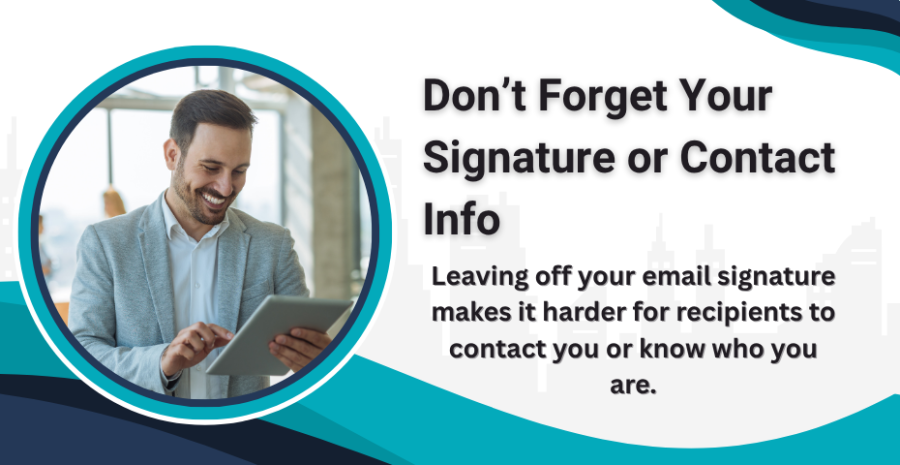
Leaving off your email signature makes it harder for recipients to contact you or know who you are.
Every professional email should include a clean signature with your full name, title, company, phone number (if needed), and relevant links.
This adds credibility and ensures the recipient knows how to respond or follow up.
A well-crafted signature also reinforces your brand identity and makes communication seamless.
Professional emails are more than just digital messages—they're reflections of your character, competence, and credibility. In a world where inboxes are overflowing and attention is limited, every word you write matters.
By avoiding slang, acronyms, negative language, vague phrasing, and formatting mistakes, you show your readers that you value their time and understand the art of clear communication. You create stronger connections, minimize misunderstandings, and elevate your personal brand—one email at a time.
The most successful professionals and entrepreneurs treat every email like a handshake: firm, respectful, and intentional. Start paying attention to the details that make your emails more effective, and you'll stand out in every inbox you enter.
Whether you’re writing to pitch an idea, solve a problem, or simply check in, make your words count.
Because in business, great communication isn't optional — it’s the foundation of success.
The choice is yours—make it count.
....................................................................................................................................................................................................
About: Andries vanTonder
Over 46 years selfemployed
He is a Serial Entrepreneur, an Enthusiastic supporter of Blockchain Technology and a Cryptocurrency Investor
Find me: Markethive Profile Page | My Twitter Account | My Instagram Acount | and my Facebook Profile.
